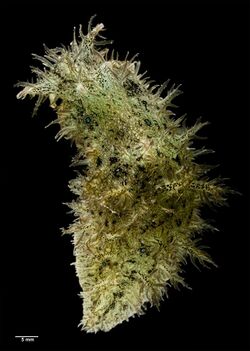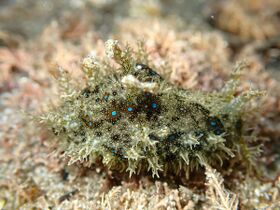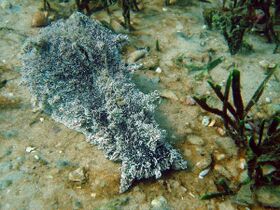Biology:Bursatella leachii
| Bursatella leachii | |
|---|---|

| |
| From the collection of Auckland Museum | |
| Scientific classification | |
| Domain: | Eukaryota |
| Kingdom: | Animalia |
| Phylum: | Mollusca |
| Class: | Gastropoda |
| Subclass: | Heterobranchia |
| Clade: | Euopisthobranchia |
| Clade: | Anaspidea |
| Superfamily: | Aplysioidea |
| Family: | Aplysiidae |
| Genus: | [[Biology:|Bursatella]] |
| Species: | B. leachii
|
| Binomial name | |
| Bursatella leachii Blainville, 1817[1]
| |
| Synonyms | |
| |
Bursatella leachii, whose common name is the ragged sea hare or shaggy sea hare, is a species of large sea slug: a marine gastropod mollusk in the sea hare family Aplysiidae.[15] It has an almost pantropical distribution, from the Mediterranean to the Caribbean, but excluding the central and eastern Pacific Ocean. Its long planktonic larval period and short life cycle make able to colonise new areas and increase dramatically in number if food supplies are favourable.
Taxonomy
After Bursatella leachii was described in 1817 by Henri Marie Ducrotay de Blainville,[1] numerous other species were added to the genus.[16] In 1935 Eales and Engel synonymised these all with B. leachii, proposing six subspecies;[7] one more was added by Bebbington in 1969,[6] at which point Bursatella was considered a monotypic genus with a nearly pantropical distribution, containing the following subspecies:
- Bursatella leachii africana Engel, 1926 (South Africa)
- Bursatella leachii guineensis Bebbington, 1969 (Ghana)
- Bursatella leachii laniculata Gould, 1852 (Brazil)
- Bursatella leachii leachii Blainville, 1817 (Indo-Pacific)
- Bursatella leachii pleii Rang, 1828 (West Indies)
- Bursatella leachii rosea Engel, 1926 (West Africa)
- Bursatella leachii savigniana Audouin, 1826 (Red Sea)
These subspecies were supposedly distinguishable by "wooliness", their background colour, and the colour of their eyespots, though other observers found these traits varied within local populations and few consistent differences could be seen.[17]
A 2020 molecular analysis by Bazzicalupo et al. found no consistent genetic differences between B. leachii subspecies, and recommended that this classification scheme be abandoned. In their view, B. leachii is a morphologically variable species with a pantropical distribution and limited gene flow between Indo-Pacific and Atlantic populations.[16] Bazzicalupo et al. resurrected the name Bursatella ocilligera (Bergh 1902) for genetically-distinct specimens from the Philippines, and that same year Nimbs and Wilson described B. hirsuta from southern and western Australia,[18] making three species in the genus Bursatella.
Distribution
This species is more widely-distributed than any almost other species of heterobranch sea slug, being found in coastal areas of the Atlantic down to South Africa and parts of the Indo-West Pacific ocean. Although it spans 20,000 km of tropical waters from the Caribbean to Japan, it is absent from the central and eastern Pacific. It has been hypothesised that the Atlantic and Indian-Pacific populations could be intermittently linked by the Agulhas Current around the tip of South Africa, explaining the small divergence in genetic sequence between the two populations.[16]
- Geographical variation in B. leachii
This species colonised the Mediterranean Sea in about the mid-20th century. It was first noted in the 1950s on the Levantine coast and Italy, reaching Morocco, southern Spain, and France in the 2000s.[19] Because it was first noted from the eastern Mediterranean, the population was assumed to have originated in the Red Sea via the Suez Canal, but genetic sequencing revealed Mediterranean and Atlantic populations had almost identical haplotypes, meaning the species probably arrived from the Atlantic.[20] Rather than being carried in ballast water like many other species invading the Mediterranean, B. leachii probably arrived naturally as sea surface temperatures that would normally prevent it entering the Strait of Gibraltar have shifted north with climate change.[20]
Description
Bursatella leachii is green to greenish brown. It has a broad and short head. Its mantle is covered with papillae (finger-like outgrowths), which give it a thorny aspect. The mantle has a network-like pattern with blue eyespots (ocelli) in black spots and green areas. It moves slowly on a broad foot. There is short, sharp tail. The short parapodia (fleshy, winglike outgrowths) are fused on their rear end.
The maximum recorded length is 120 mm.[21]
Ecology
The species is usually found in protected marine bays and estuaries, tidal pools, occurring in the intertidal zone and down to at least 10 m.[22] It is a benthic detritivore which grazes for food on muddy or sandy bottoms.[16] Populations in the wild have been observed feeding on a range of macroalgae including the green alga Enteromorpha, as well as the cyanobacteria Calothrix crustacea, forming large populations in response to bacterial blooms.[23]
This sea hare may be found in dense concentrations or singly; it follows a daily rhythm, assembling in groups at sunset and dispersing in the morning.[24] These patterns are also followed in captivity, with copulation predominantly in the morning and feeding in the afternoon.[24] The species lays egg ribbons in long green stringy tangles.[25] After hatching the veliger larvae grow rapidly and reach full size at 15 days, and are able to metamorphose to adult form aged just 19 days (the shortest larval period reported for sea slugs), but can live as plankton for up to three months. Larvae metamorphose on cyanobacteria, taking 1–2 days, discarding their shell when they reach 2.5–3.0 mm long. Adults grow relatively quickly, attaining maturity at the age of 2 or 3 months after hatching.[26]
References
- ↑ 1.0 1.1 Blainville, Henri Marie Ducrotay de. (1817.) "Bursatella," in: Dictionnaire des Sciences Naturelles (F. Cuvier, ed.), vol. 5, supplément, p. 138. Levrault, Strasbourg & Le Normant, Paris.
- ↑ Griffin L.E. (1912). "The anatomy of Aclesia freeri new species." The Philippine Journal of Science. section D, 7(2):65–90, pls 1-6.
- ↑ Cheeseman, T.F. (1878). "Descriptions of three new species of opisthobranchiate Mollusca from New Zealand." Proceedings of the Zoological Society of London. 1878:275–277.
- ↑ Engel H. (1926). "Drei neue Arten der Gattung Aclesia (Rang) Bergh, 1902." Zoologischer Anzeiger. 69:180-187.
- ↑ Rang S. (1828.) Histoire naturelle des Aplysiens. Paris: Firmin Didot. 83 pp. 24 pls.
- ↑ 6.0 6.1 Bebbington A. (1969) "Bursatella leachi guineensis subsp. nov. (Gastropoda, Opisthobranchia) from Ghana." Proceedings of the Malacological Society of London 38: 323-341.
- ↑ 7.0 7.1 Eales, N. & Engel, H. (1935.) "The genus Bursatella De Blainville." Proceedings of the Malacological Society of London 21:279-303, plate 31. page(s): 298
- ↑ Gould, A.A. (1852). "Mollusca and shells." In: United States Exploring Expedition during the years 1838, 1839, 1840, 1841, 1842 under the command of Charles Wilkes. Boston. 12:1-510; atlas 1856: 1-16.
- ↑ Hägg R. (1904). "Two new Opisthobranchiathe Mollusca from the Red Sea." In: L. A. Jägerskiöld (ed.), Results of the Swedish Zoological Expedition to Egypt and the White Nile 1901 under the direction of L. A. Jägerskiöld, Part 1: 1–16, pl. 1.
- ↑ Stimpson W. (1855). "Descriptions of some of the new Marine Invertebrata from the Chinese and Japanese Seas." Proceedings of the Academy of Natural Sciences, Philadelphia. 7(10):375-384.
- ↑ Rüppell E. & Leuckart F.S. (1828-1830). "Mollusca [in] Atlas zu des Reise im Nordlichen Afrika von Eduard Rüppell. 1. Abth. Zoologie. 5. Neue wirbellose Thiere des Rothen Meers." Frankfurt, H.L. Brönner pp. 1-22, pl. 1-12.
- ↑ Audouin V. (1826.) "Explication sommaire des planches de Mollusques de l'Egypte et de la Syrie publiées par J.C. Savigny." in: '"Description de l'Egypte ou recueil des observations et des recherches qui ont été faites en Egypte pendant l'expédition de l'armée française, publié par les ordres de sa majesté l'empereur Napoléon le grand." Histoire Naturelle, Animaux invertébrés 1(4): 7-56. Paris: Imprimerie impériale
- ↑ O'Donoghue, C.H. (1929.) "Opisthobranchiate Mollusca collected by the South African Marine Biological Survey. Union of South Africa." Fisheries & Marine Biological Survey Report No. 7 for the year ending June 1929. pp. 1-84, pls. 1-8. Special Reports No. 1. page(s): 25–30, pl. 3 figs 27–32
- ↑ Allan, J.K. (1932). "A new genus and species of sea-slug, and two new species of sea-hares from Australia." Records of the Australian Museum. 18:314–320.
- ↑ MolluscaBase eds. (2021). MolluscaBase. Bursatella leachii Blainville, 1817. Accessed through: World Register of Marine Species on 2021-01-27.
- ↑ 16.0 16.1 16.2 16.3 Bazzicalupo, Enrico; Crocetta, Fabio; Gosliner, Terrence M.; Berteaux-Lecellier, Véronique; Camacho-García, Yolanda E.; Chandran, B. K. Sneha; Valdés, Ángel (2020). "Molecular and morphological systematics of Bursatella leachii de Blainville, 1817 and Stylocheilus striatus Quoy & Gaimard, 1832 reveal cryptic diversity in pantropically distributed taxa (Mollusca : Gastropoda : Heterobranchia)" (in en). Invertebrate Systematics. doi:10.1071/IS19056. ISSN 1445-5226. http://www.publish.csiro.au/?paper=IS19056.
- ↑ Rudman, W.B. (12 Jan 2007). Comment on Bursatella leachii subspecies by Augusto Medeiros. [Message in] Sea Slug Forum. Australian Museum, Sydney.
- ↑ Nimbs, Matt J.; Wilson, Nerida G. (2020). "Description of a new species of Bursatella Blainville, 1817 (Gastropoda, Aplysiida, Aplysiidae) from southern Australia" (in en). Molluscan Research 40 (4): 369–378. doi:10.1080/13235818.2020.1837055. ISSN 1323-5818. https://www.tandfonline.com/doi/full/10.1080/13235818.2020.1837055.
- ↑ Selfati, Mohamed; El Ouamari, Najib; Crocetta, Fabio; Mesfioui, Abdelhakim; Boissery, Pierre; Bazairi, Hocein (2017). "Closing the circle in the Mediterranean Sea: Bursatella leachii Blainville, 1817 (Mollusca: Gastropoda: Anaspidea) has reached Morocco". BioInvasions Records 6 (2): 129–134. doi:10.3391/bir.2017.6.2.07. http://www.reabic.net/journals/bir/2017/Issue2.aspx.
- ↑ 20.0 20.1 Bazzicalupo, Enrico; Crocetta, Fabio; Estores-Pacheco, Ka‘ala; Golestani, Haleh; Bazairi, Hocein; Giacobbe, Salvatore; Jaklin, Andrej; Poursanidis, Dimitris et al. (2018). "Population genetics of Bursatella leachii (De Blainville, 1817) and implications for the origin of the Mediterranean population". Helgoland Marine Research 72 (1): 19. doi:10.1186/s10152-018-0521-7. ISSN 1438-3888.
- ↑ Rosenberg, G. (2009.) Malacolog 4.1.1: A Database of Western Atlantic Marine Mollusca. [WWW database (version 4.1.1)] .
- ↑ Zsilavecz, Guido (2007). Nudibranchs of the Cape Peninsula and False Bay. Cape Town: Southern Underwater Research Group. ISBN 978-0-620-38054-6. OCLC 181910103. https://www.worldcat.org/oclc/181910103.
- ↑ Clarke, Cathryn L. (2006). "The population dynamics and feeding preferences of Bursatella leachii (Opisthobranchia: Anaspidea) in northeast Queensland, Australia" (in en). Records of the Western Australian Museum, Supplement 69 (1): 11. doi:10.18195/issn.0313-122x.69.2006.011-021. ISSN 0313-122X. http://museum.wa.gov.au/research/records-supplements/records/population-dynamics-and-feeding-preferences-bursatella-leachii-.
- ↑ 24.0 24.1 Ramos, L. J.; Rocafort, J. L. L.; Miller, M. W. (1995). "Behavior Patterns of the Aplysiid Gastropod Bursatella leachii in Its Natural Habitat and in the Laboratory" (in en). Neurobiology of Learning and Memory 63 (3): 246–259. doi:10.1006/nlme.1995.1029. ISSN 1074-7427. PMID 7670838. https://www.sciencedirect.com/science/article/pii/S1074742785710295.
- ↑ Gosliner, T.M. 1987. Nudibranchs of Southern Africa ISBN:0-930118-13-8
- ↑ Paige, John A. (1988). "Biology, Metamorphosis and Postlarval Development of Bursatella leachii plei Rang (Gastropoda: Opisthobranchia)". Bulletin of Marine Science 42 (1): 65–75. https://www.ingentaconnect.com/content/umrsmas/bullmar/1988/00000042/00000001/art00004.
External links
- Images
- Photos of Bursatella leachii on Sealife Collection
- B. leachii featured on RNZ Critter of the Week, 20 May 2022
Wikidata ☰ Q3141642 entry
 |






